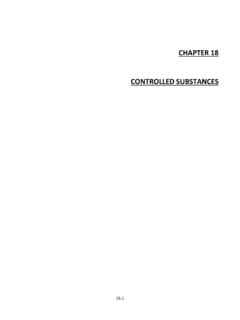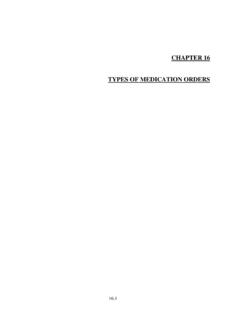Transcription of CHAPTER 22 EMERGENCY MEDICATION KIT
1 CHAPTER 22. EMERGENCY MEDICATION KIT. HOSPITAL. EMERGENCY DRUGS. 1. EMERGENCY Drugs Used in the Hospital Crash carts Resuscitation or MEDICATION trays Various EMERGENCY kits or boxes Eclampsia kit Malignant hyperthermia cart 2. Standardize Format carts, trays or kits Specific drugs used Crash cart drugs directed by ACLS guidelines (last updated 2000). May differ for adults and pediatrics Location of drugs and supplies in the cart Staff can quickly find what is needed Education of staff on a continual basis 3. EMERGENCY medications must be secure (TX ). Assure medications are available when needed Prevent tampering Options Plastic break away lock or plastic wrap No lock with regular inventory to assure contents are present kept in a locked room under constant surveillance 4.
2 Plastic locks Advantages of plastic locks Expiration date placed on lock When sealed lets staff know contents are complete and within their expiration date Staff checks seal each shift and document Once seal is broken signifies contents removed or expired Seal intact and within expiration date do NOT need to check contents Plastic locks MUST be controlled by the pharmacy 5. Documentation to show QA check Filled by/checked by Lot & expiration date 6. Common crash cart system in Hospital exchange system with ready-to-go back-up carts (May use different color seal when returning used cart). SAMPLE CRASH CART USED IN THE HOSPITAL. SAMPLE POLICY: EMERGENCY MEDICATION and Crash Cart System POLICY: EMERGENCY medications are consistently available, controlled, and secure in the pharmacy and patient care areas.
3 PROCEDURE: A. Tamper Locks: 1. Pharmacy personnel shall NOT issue YELLOW tamper locks to any non-pharmacy personnel. B. Crash Cart Exchange System: 1. Receiving and dispensing Crash Carts: a. The pharmacist or Pharmacy technician who receives the cart will verify that the MEDICATION sections are sealed with a white zip-tie seal. If not, the pharmacy supervisor will be notified immediately. b. Sterile Processing is responsible for cleaning and stocking the crash cart with supplies and respiratory equipment before bringing it to the pharmacy. The pharmacy technician or pharmacist who receives the cart shall check the MEDICATION drawers and trays for obvious contamination. If the cart or drug trays are contaminated with blood or body fluids, pharmacy personnel shall not accept the cart.
4 The cart must be accompanied with the patient's name and account number. If these are absent, Sterile Processing must be contacted, unless the cart is being returned because of expired medications. The new form shall be filed in the Crash Cart notebook behind the corresponding crash cart divider number and the old form shall be removed. Attach the slip with the patient's name and account number to the old form. The crash cart shall be sealed with a YELLOW numbered plastic breakaway lock. The shortest expiration date for the entire cart will be indicated on a tag on the lock. Refilling and sealing of the crash cart will be completed within 1 hour after delivery to pharmacy. c. The pharmacist or technician will transport the restocked and locked crash cart to Sterile Processing as soon as possible.
5 2. Restocking the Crash Cart: a. Before restocking the crash carts, the old form that had been filed in the crash cart notebook shall be used to document and charge the medications that were used during the code. The technician shall inventory the MEDICATION drawers and document on the old form the medications that were used or are missing. The old form will then be forwarded to the technician responsible for charging. When charging is complete the technician shall date, initial and write or stamp "Charged" on the form. The technician shall then file the old form in the file cabinet according to the date. b. In-patient crash cart MEDICATION drawers shall be restocked according to the form "Pharmaceutical Med/Surg, Crash Cart Check List" (Appendices).
6 Carts shall be restocked with medications that are to expire no sooner than 6 months from date of restocking. If the MEDICATION drawers are soiled with dust or dirt, the technician shall clean the drawers with a damp cloth and dry prior to restocking. When the drawers are restocked, the earliest expiration date for each item will be recorded in the column marked "EXP. DATE" on the "Pharmaceutical Check List" form. The earliest expiration date of all medications in the cart is then denoted on the top of the form. All MEDICATION drawers shall be double-checked prior to dispensing . The pharmacist or technician who has restocked the cart and the pharmacist who double checks the cart shall sign and date the form in the spaces provided at the top of the form.
7 The form is filed under the number of the cart. C. EMERGENCY Department (ED) Adult & Pediatric Resuscitation Trays: 1. Adult ED resuscitation trays consist of a single beige tray and pediatric ED Resuscitation trays consist of a single blue tray. A supply of pre-stocked trays shall be kept in the pharmacy. Technicians shall exchange used Resuscitation trays with restocked Resuscitation trays as needed on a daily basis. The used or opened tray must be accompanied by the patient's name, account number and "ED Adult/Pediatric Resuscitation Checklist" form. 2. Drug trays that are contaminated with blood or body fluids shall not be handled or transported by pharmacy personnel. In this case ED Nursing personnel shall be asked to discard contaminated drug and drug containers and transport the contaminated drug tray to Sterile Processing for cleaning and sterilization.
8 The rest of the medications that are not contaminated shall be bagged with the checklist form for the tray, the patient's name and account number, and retained by pharmacy for billing. 3. Before restocking the ED resuscitation trays, the old checklist form shall be used to document and charge the medications that were used in the code. The technician shall inventory the MEDICATION tray, document on the old form the medications that were used or are missing and deliver the completed checklist form to the charging area. If ED personnel were not able to attach a patient's name to the resuscitation tray at the time the pharmacy technician exchanged trays, then the charging technician shall charge the ED Department for any used or missing medications.
9 When charging is complete the charge technician shall date, initial and write or stamp "Charged" on the form. The technician shall then file the old form in the file cabinet according to the date. 5. The liaison pharmacist is responsible for checking on a monthly basis the expiration dating of the resus trays and replacing trays that are soon to expire. the old form in the file cabinet according to the date. ED RESUSCITATION TRAY PROCEDURES CHECK LIST. (See Policy # Rx 01-006 for additional information). A. EXCHANGE PROCEDURES. 1. Used ED resus trays shall be exchanged by the technician making the 10:00 AM refill delivery. 2. The technician shall carry pre-stocked adult and pediatric resuscitation trays (located in the rolling shelves on shelf "L") with him/her to exchange for used trays.
10 Select trays that have the shortest expiration dating but are at least 6 months from the date of restocking. 3. In the ED, check the MEDICATION trays for contamination of blood or body fluids. If the tray is contaminated, ask ED personnel to discard contaminated drug and drug containers and transport the contaminated drug tray to Sterile Processing for cleaning and sterilization. The remaining medications should be bagged together with the checklist form from the tray for billing. 4. Bring the tray back to pharmacy for restocking. 5. Before restocking the ED resus trays the technician shall: a. Check the MEDICATION tray using the old checklist form. b. Document on the old form the medications that were used or are missing.










